The Japanese or Japanese Diet was developed by nutritionists at the YaELO Clinic (Yaeks). The principle of the technique is based on the use of low-calorie food for 7-14 days. Before starting a strict diet, experts recommend preparing yourself mentally - the weight loss system requires strict adherence to all the rules of the method. This system of eliminating excess weight is characterized by a long outcome: it lasts 4 weeks. Despite its high effectiveness, the diet can harm the body, especially if there are contraindications.

Weight loss principle
The Japanese diet is designed for 7, 14 or 13 days. Proper weight loss is accomplished through the use of foods high in protein. Foods high in carbohydrates and fat are excluded from the diet. The technique is considered "salt-free". The initial stage of weight loss is accompanied by the normalization of metabolic processes in the body and the elimination of toxins. The fat burning process begins on days 2-3.
It is impossible to deviate from the regime - the diet is strictly prescribed. Due to the lack of carbohydrates in the dishes, the duration of the diet should not exceed 14 days. The occurrence of side effects requires immediate discontinuation of diet therapy and is the reason for contacting a medical facility. The use of vitamins and minerals when losing weight is promoted, the complex is selected individually. Discontinuing the diet can take up to a month.
Diet rules

Dishes made from approved foods can fill you up quickly. This is due to the presence of the main component "building" - protein - in their composition. Carbohydrates and fats enter the body in small amounts. Dietary fiber is found in fresh vegetables and fruits and their use is not limited. Soluble fiber contributes to normalFunction of the digestive system: Antioxidants involved in the metabolism are found in green tea and natural coffee.
A specially selected menu for every day provides the body with the necessary nutrients.
The drinking regime must be strictly adhered to: at least 1. 5 liters of liquid must be drunk per day. The presence of salt, sugar and hot spices in dishes is unacceptable. The number of meals is limited: no more than three times a day. You can't have snacks.
Experts recommend avoiding sweets and junk food in advance - this will help avoid a breakdown. It is recommended to reduce the servings.
Permitted and prohibited products
The list of products approved for consumption is strictly limited. For 14 days, the menu of the day can include:
- Meat and poultry products;
- a fish;
- Bread;
- Vegetables;
- Fruit;
- natural freshly squeezed juices;
- Dairy products;
- Tea and still mineral water.
Vegetables, Fruits, and Vegetables That You Can Eat:
- Zucchini;
- Carrot;
- Aubergine;
- Cabbage;
- Apples;
- Pineapple;
- Pears;
- Kiwi;
- Pomelo;
- Citrus fruits (lemons, oranges).
Bread and rusks should be rye. Lean meat (lean beef, chicken, turkey) and fish (hake, blue whiting, cod) are heat treated. Eggs are allowed, but in small quantities. Beverages (green tea, natural weak coffee, boiled water) should not contain any sweeteners. You can drink tomato juice and low-fat (1%) kefir. Olive oil is included in the diet.
Prohibited foods must be completely excluded from the menu. These include:
- fatty meat and fish;
- Vegetable oils;
- Salt and sugar;
- Fast food;
- Flour products;
- smoked and cooked sausages;
- Semi-finished products and canned food;
- Sweets and pastries;
- Starchy foods (vegetables, cereals);
- Alcohol and tobacco products;
- Sauces, marinades.
Vegetables and fruits:
- Cherry;
- Cherries;
- Garnet;
- Persimmon;
- Mandarins;
- Mango;
- Figs;
- Passion fruit;
- Grape.
Dried fruit:
- Plums;
- Raisin;
- dried apricots;
- Events.
The Japanese rarely eat dairy products as they are often lactose intolerant and therefore not included in the diet.
Potato chips, sweet and salty popcorn must be excluded from the diet. Semolina, barley and millet groats are not used in cooking foods that promote fat burning.
Prohibited flour products:
- Pancakes;
- Dumplings;
- Vareniki;
- Spaghetti (pasta);
- Pancakes;
- Pasta;
- Wheat bread;
- Muffin.

Confectionery (sweets, cookies, pastries, rolls, cakes, marshmallows, halva, jams, jams) are strictly prohibited. Spices (spices, mayonnaise, ketchup) are not added to the dishes. Any milk products (sour cream, cheese, fermented baking milk, whole milk, cream) are prohibited.
Meat and sausage:
- Pork meat;
- Mutton;
- Ham;
- boiled pork;
- Salo;
- smoked sausages;
- uncooked smoked, boiled, cured sausages.
Dried, smoked and dried fish should be removed from the menu immediately. Poultry meat is only consumed in cooked form. Do not use chocolate, ghee, and butter. Alcoholic beverages and tobacco products are excluded 2-3 weeks before weight loss. Sweet drinks with a high carbonic acid content (lemonade, kvass) are replaced by still mineral water.
Dried fruit compote, jelly are not included in the drinking diet. You should also avoid cherry, apple, pomegranate, grape and orange juices. Nectars are prepared from pineapples and tomatoes, they are drunk in small quantities.
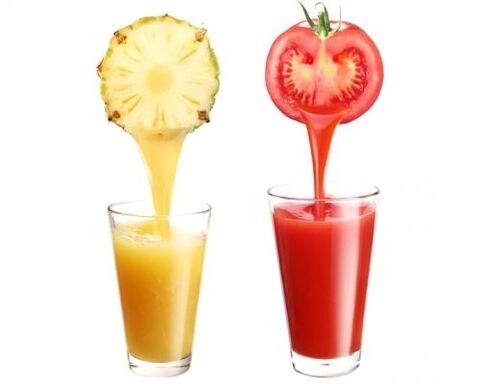
Types of Japanese Diet
There are 3 types of Japanese diets. They differ in the number of days:
- 7 days;
- 13 days;
- 14 days.
The nutritional scheme must be followed regardless of the type of technique.
Diet 14 days
The salt-free slimming system is designed for 2 weeks. During this time, fat cells are gradually released and burned. The body is cleansed for the first 3 days. During this period, experts recommend drinking a lot: boiled water and green tea will accelerate the flushing out of the remaining toxins. Traditionally, the diet can be divided into 2 phases, each lasting 7 days. At the first stage, kefir is included in the menu. Dishes are steamed, frying and roasting are ignored.
Diet for 7 days
The gentlest technique is designed for a week. During this time, you can not lose more than 3-4 kilograms. The menu is strict, the products are strictly limited and cannot be replaced. During weight loss, there is a restructuring in which the body gets used to the new diet, so experts consider this system to be the least effective. The menu may include traditional Japanese cuisine prepared with approved ingredients. They cannot be supplemented. For people looking to lose weight, according to Japanese women, nutritionists recommend choosing the "lightweight" option.
Diet for 13 days
The principle of operation of this type is no different from the previous two. The portion weight does not exceed 200 g, liquid is consumed when thirsty. Food intake - simultaneously for 13 days. Compliance with all the rules of the detox diet is mandatory. A complete cleansing of the intestines takes place in less than 2 weeks. The process of burning fat takes place gradually, so the skin in problem areas retains its elasticity. The consumed energy supply is replenished with protein-containing foods.
Diet plan by day
Slimming dishes are fully adapted to European cuisine and do not contain any exotic ingredients. The approximate menu is designed for 7 days, on the 8th day it is repeated. It is allowed to vary drinks: replace coffee with green tea, kefir - with tomato juice. The daily product norm, if necessary, is divided into 2 parts depending on the number of days (with weekly weight loss).
Diet plan (for 14 days):
- chicken fillet - 1 kg;
- Fish fillet - 2 kg;
- lean beef - 1 kg;
- Crackers or rye bread - 0. 5 kg;
- chicken eggs - 20 pcs . ;
- White cabbage - 2 pcs . ;
- zucchini and / or eggplant - 1 kg;
- carrots - 2, 5-3 kg;
- fruits (unsweetened) - 1 kg;
- lemons (large) - 2 pieces;
- Kefir (low-fat) - 1 l;
- Olive oil - (cold pressed) - 0. 5 l;
- Tomato juice (homemade) - 1 liter;
- natural coffee (grains or powder) - 1 pack;
- green (large leaf) tea - 1 pack.
The water consumption depends on the age and weight of the person.
The food set is sufficient for three meals a day. Non-carbonated mineral water can be replaced with boiled water. The minimum volume of fluid per day is 1. 5 liters.
Detailed plan of the daily menu (by day):
- For breakfast (8, 00) - a cup of weak natural coffee. Cream, sugar, condensed milk should not be added. For lunch (13. 00) - finely chopped cabbage stewed in its own juice with the addition of a small amount of olive oil, 2 hard-boiled eggs and 250 ml of tomato juice. For dinner (18. 00) - fish (200 g boneless fillet), steamed or boiled.
- Breakfast - coffee without milk and sugar, a slice of rye bread. Lunch - cabbage braised with olive oil and steamed (boiled) fish fillets (100 g). Dinner - boiled beef (100 g) and 250 ml of low-fat kefir.
- For breakfast - a cup of weak natural coffee and a rye croton. For lunch - a vegetable stew made from eggplant or zucchini. For dinner - a salad of fresh white cabbage, seasoned with oil. You can eat 2 eggs and 200 g of boiled lean beef (porridge).
- Breakfast - raw carrot puree, lemon juice. Lunch - boiled fish fillet without bones (200 g), 250 ml of tomato juice. Dinner - unlimited fruit.
- For breakfast - raw carrot puree, lemon juice. For lunch - boiled fish fillet without bones (200 g), a glass of tomato juice. For dinner - any amount of fruit.
- Breakfast - coffee or green tea without sugar. Lunch - 0, 50 cooked chicken (breast or thighs without skin), fresh vegetable salad (carrots and cabbage) with a little oil. Dinner - boiled chicken eggs (2 pcs. ), Salad from freshly grated carrots with butter.
- For breakfast - green tea without sugar. For lunch - steamed or boiled beef. For dinner - any dish (except dinner for 3 nights).
The menu can be shown schematically. Experts recommend placing a sheet with a drawing in a noticeable place.
The right way out of the diet
Some type of dietary nutrition must be followed 2-4 weeks after the diet. When losing weight, the body gets used to small portions and low-calorie foods. Avoiding the diet is necessary to maintain normal weight and optimal digestive tract function. It is recommended to gradually return to the usual diet: foods rich in carbohydrates are added a little every day. The approval period is at least 14 days.
Meals should be fractionated, the weight of the portion should not be increased. The diet should be dominated by foods that are low in calories and replenish the energy stored during weight loss. It is not recommended to reduce the consumption of protein foods (chicken eggs, poultry, and fish). In the menu, fats and carbohydrates are gradually introduced. Salt and sugar can be added in microdoses. Drink plenty, do not consume more than 2 liters per day.
During the termination of the diet, it is allowed to have cereals for breakfast. Oatmeal, buckwheat, and rice groats are boiled in water. Vegetables and fruits are eaten raw in any quantity. It is best to prefer sweet and sour apple varieties. Snacks are introduced between main meals: a glass of kefir or rice cake. Rye bread is replaced by whole grain bread or yeast-free bread.
Pasta and confectionery, baked goods and snacks are not part of the menu.
Diet costs
Approved products for weight loss are in the middle price segment.
advantages and disadvantages
The Japanese technique of losing weight has a number of advantages and disadvantages. The benefits include:
- Efficiency;
- Availability;
- Cleaning at the same time as slimming;
- detailed menu;
- Three meals a day;
- increased muscle tone.
Its effectiveness is based on the rapid process of burning fat, the result appears after 7 days. The products are available to everyone and can be bought in any store. There is no need to calculate calories in advance, the menu is clearly written. The food is eaten three times a day, the diet is hearty, so the feeling of hunger rarely appears. Cleansing the body helps normalize metabolic processes. The high protein content in food strengthens the muscle structure.
The disadvantages are:
- unbalanced diet;
- Lack of vitamins and minerals;
- Lack of hearty breakfast;
- the need to adhere to the rules for ending the diet;
- short term weight loss;
- Contraindications.
An unbalanced diet and non-compliance with the ratio of fats, proteins and carbohydrates increase the risk of side effects. A decrease in natural defensive reactions, a deterioration in the condition of nails and hair occurs against the background of a lack of vitamins in the body. The correct way out of the diet will prevent the emergence of stressful situations, which can lead to rapid weight gain.
Contraindications and harm

The diet is only suitable for healthy people. Before losing weight, you need to undergo an examination and consult a nutritionist. Contraindications are:
- Pregnancy anytime;
- Breastfeeding;
- Gastric and duodenal ulcers;
- erosive damage to the digestive system;
- pathology of the kidneys and liver, including failure;
- Anemia;
- Gallbladder disease;
- Diseases of infectious etiology;
- pathology of the cardiovascular system;
- Hypovitaminosis;
- Diabetes mellitus;
- Increases in blood pressure;
- Exacerbation of chronic diseases;
- Gout.
The diet is not suitable for the elderly and adolescents. Any failure to observe the general rules of technology increases the risk of side effects. In the first few days, nausea and stool disorders (constipation or diarrhea) may occur. Indigestion is accompanied by excessive gas or colic. Bad breath, heartburn and belching occur. Headache occurs against a background of complete refusal to sugar.
Neuroses and sleep disorders arise for the same reason. The lack of fat creates a bitter taste in the mouth. The appearance may deteriorate: the skin becomes pale and dry. Lack of nutrients leads to joint pain.
Diet recipes
Diet meals are added to the menu upon exiting. You can diversify your diet with salads, first and second courses. Homemade desserts with low sugar content improve brain function and can be consumed after 14-15 days.
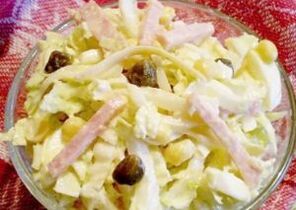
"Hope" diet salad contains the following ingredients:
- potatoes - (2 pieces);
- Milk sausages - (2 pcs. );
- chicken breast - (250 g);
- pickled cucumber - (1 pc. );
- Greens;
- Salt;
- Olive oil - (1 tablespoon).
Cut the boiled potatoes, boiled chicken and sausages into cubes. Put the mixture in a deep bowl and season with salt. Add cucumber cut into strips and finely chopped greens.
Season the salad with olive oil (first pressing).
Coleslaw:

- Peking cabbage - (250 g);
- fresh cucumbers and tomatoes - (250 g);
- Chili pepper - (1 pc. );
- hard cheese - (150 g);
- Salt;
- olives (1/2 can);
- Olive oil.
Tear the Chinese cabbage leaves into small pieces with your hands. Cucumbers and tomatoes are cut into large pieces. Chop the chilli (half a vegetable) in a blender. Mix all ingredients, season with salt and season with oil. Garnish the salad with grated cheese and olives.
The first courses are consumed at lunchtime. Soups are pureed to make them easier to digest. Spinach and Celery Soup:
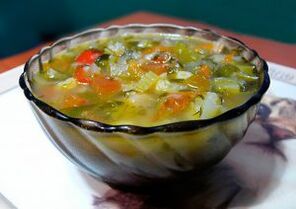
- lemon - (1 pc. );
- tomatoes - (2 pieces);
- Spinach - (200 g);
- Celery - (stem, 2 pcs. );
- Greens;
- Vegetable broth - (1, 5 l);
- Salt;
- Olive oil - (1 tbsp. L. ).
Put the olive oil in a preheated pan. Finely chop the celery stalk and fry in oil. In a separate saucepan, bring the broth to a boil, add the chopped spinach and simmer for 5–7 minutes. Remove the skin from the tomatoes and grind in a blender. Add tomato paste to the spinach. Salt the broth, fry. Cook for 15-20 minutes. Add some lemon juice and chopped herbs to the finished soup.
Mushroom cream soup:
- Mushrooms - (8 pcs. );
- potatoes - (2 pieces);
- zucchini - (300 g);
- carrots - (1 pc. );
- onion - (1 pc. );
- weak meat broth - (1 l);
- flour - (1 tbsp. l. );
- Olive oil - (2 tbsp. L. );
- Cream - (1 tbsp. L. ).
Cut the cooked vegetables into small cubes and chop in a blender. Bring the broth to a boil. Fry the flour until golden brown, add to the broth, then add the vegetable puree. Simmer the soup over low heat until thickened, then salt, add cream and garnish with herbs. The first course is served with rye crotons.
Beef goulash with vegetables:
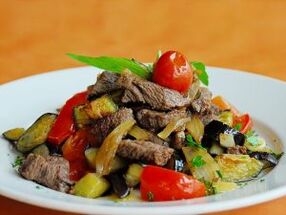
- beef - (500 g);
- Olive oil - (3 tbsp. L. );
- potatoes - (200 g);
- carrots - (1 pc. );
- Paprika - (1 pc. );
- onions - (1 pc. ).
Divide the onion, bell pepper and grated carrots in half rings in olive oil. Half-cook the beef, let it cool and cut into small bars. Put the meat on fried vegetables, salt. Top with potatoes cut into strips. Salt again. Add the meat stock to the vegetables. Cook the dish over low heat for 25-30 minutes.
Indian manti is a dietetic dish that is prepared in 2 stages. Ingredients for the dough:
- flour - (1, 5 cups);
- warm water - (1 glass);
- Salt.
Dissolve salt in warm water. Put the flour on the work surface, make a well. Pour in salted water in portions and gradually knead the elastic dough. Cover with a towel and let rest for 15-20 minutes.
While the dough "fits", you need to prepare the dressing. Components required:
- Mushrooms - (6-8 pcs. );
- carrots - (1 pc. );
- Spring onions - (4–5 feathers);
- zucchini - (400 g);
- Olive oil - (2 tbsp. L. );
- Tomato paste - (2 tbsp. L. );
- chicken fillet - (400 g).
Cut the mushrooms, zucchini and carrots into small cubes. Boil the chicken fillet and cut into strips. Fry the onions in oil and tomato paste, gradually adding the carrots, zucchini, mushrooms and meat. Pour 150-200 ml of water into the roast and simmer the vegetables until they are soft.
Roll out the dough into thin strips and brush each with oil. Cut the strips into squares (10x10 cm) that are stacked on top of each other. The dough is steamed in a pressure cooker or slow cooker for 15-20 minutes. The "dough columns" are laid out on a bowl, poured with vegetable sauce and sprinkled with herbs.
Results and evaluations
In 2 weeks you can lose 8-9 kg. Most of the women and men who have lost weight using this technique speak positively about it.
First evaluation, female, 36 years old
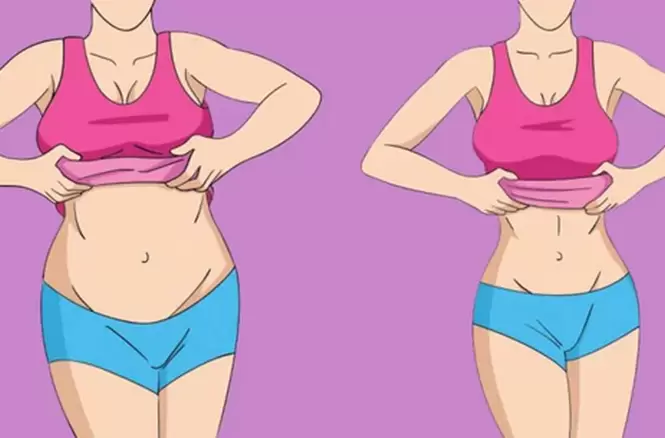
I began to recover in adolescence, I tried a lot of diets - they did not help. I went to a nutritionist, underwent a medical exam, ate separately, constantly calculated calories, arranged days of fasting, and was only able to lose 2 kilograms in 5 months. The Japanese fat burning system was recommended to me by a friend, I failed to lose 7 kg in 2 weeks. I decided to give it a try.
The medical examination revealed no contraindications. The nutritionist gave detailed diet recommendations. The system does not require large material investments. On the doctor's advice, she painted out the menu in detail and attached the sheet to the refrigerator. In the first 3 days I almost failed: the portions looked small, the feeling of hunger was always present. On the 4th day it was easier, I tried to chew longer and drink more fluids.
The second phase of losing weight went by in a flash. I cooked on the machine: I remembered the ingredients of the dishes and their weight. The food seemed satisfactory, the hunger practically disappeared. There were no side effects, except for a short-term headache on day 3. The nutritionist explained that this was due to a lack of sugar. I left the diet for 20 days. I liked the food at the exit, so I completely avoided sweet, fatty, salty and smoked dishes. I'm satisfied with the result: I lost 10. 5 kg in 2 weeks. I will be using this weight loss system again in six months.
Second review, female, Jan.
I got to know the technique 2 years ago. At that time she weighed 107 kg, with an increase of 164 the number is critical. There were health issues and I wasn't happy with the way it looked. Her friends couldn't recommend an effective diet, so she decided to consult a specialist. The doctor recommended using the Japanese weight loss system to lose weight. The long shopping list was initially shocking, but the nutritionist calmed down and explained the diet in detail.
It took 5 kg for 7 days. The dishes from the menu are hearty, I ate one portion. At first there was a slight dizziness and a slight intestinal upset. The side effects went away on their own. At the same time, she ate food. The second phase of losing weight was simple: there was lightness, appearance, and general well-being improved. Thanks to the diet, I gave up smoking and gave up alcohol completely. 13 kg walked during the release time. For 1. 5 years I have been eating properly, swimming and jogging, my previous weight has not returned.
















































































